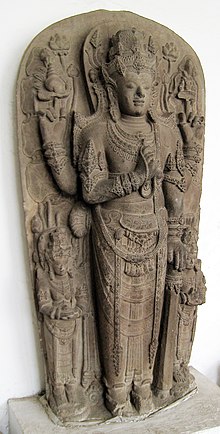Raden Wijaya
| Raden Wijaya | |||||
|---|---|---|---|---|---|
| Monarch of Majapahit Empire | |||||

The statue of Harihara, the god combination of Shiva and Vishnu. It was the mortuary deified portrayal of Kertarajasa. Originally located at Candi Simping, Blitar. (National Museum of Indonesia, Jakarta)
|
|||||
| Reign | Majapahit: 1294–1309 | ||||
| Coronation | 1294 | ||||
| Successor | Jayanegara | ||||
| Died | 1309 Majapahit |
||||
| Consort | Tribhuwana | ||||
| Spouse | Gayatri Rajapatni | ||||
| Wives |
|
||||
|
|||||
| Dynasty | Rajasa Dynasty | ||||
| Religion | Hinduism | ||||
| Full name | |
|---|---|
| Kertarajasa Jayawardhana |
Raden Wijaya (also known as Nararya Sangramawijaya, regnal name Kertarajasa Jayawardhana), Raden Vijaya, (reigned 1293–1309) was a Javanese King, the founder and the first monarch of Majapahit empire. The history of his founding of Majapahit was written in several records, including Pararaton and Negarakertagama. His rule was marked by the victory against the army and the navy of Kublai Khan's Yuan dynasty, division of the Mongol Empire.
There are several version of his ancestry.
According to Pararaton, Raden Wijaya was the son of Mahisa Campaka, prince of Singhasari.
According to Pustaka Rajyarajya i Bhumi Nusantara, Raden Wijaya was the son of Rakeyan Jayadarma (son of Sunda-Galuh King Prabu Guru Darmasiksa) and Dyah Lembu Tal (daughter of Mahisa Campaka from Singhasari). Rakeyan Jayadarma was poisoned and after her husband's death, Dyah Lembu Tal returned from Sunda-Galuh Kingdom to Singhasari with Raden Wijaya. This story is similar to that of Babad Tanah Jawi which mentioned the founder of Majapahit was Jaka Sesuruh, a son from the king of Pajajaran's which is located in Sunda Kingdom. Jaka Sesuruh ran to the east because of a rivalry with his step brother Siyung Wanara.
Alternatively with Nagarakretagama, Dyah Lembu Tal, also known as Dyah Singhamurti, was a man and the great-grandson of Ken Arok, king of Singhasari (1222–1227) and Ken Dedes, by their son Mahisa Wonga Teleng, and his son Mahisa Campaka (Nara Singhamurti). Because Nagarakretagama was written in 1365, 56 years since the Raden Wijaya's death, popular opinion supports it.
...
Wikipedia
